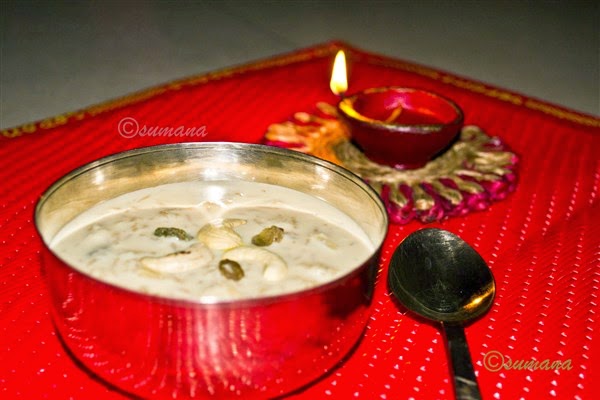Khejur Gurer Chaler Payesh|Rice Kheer Recipe
Khejur gur is one of the
most important and favorite ingredient to make Bengali dessert. Bengalis wait
throughout the year – when the winter season will come. Winter is very graceful
in Bengal and comes with its bounty of seasonal flowers and vegetables, along
with some important festivals like Poush Sankranti. Bengalis
love winter as some of their most favourite foods and desserts are prepared
with ingredients mostly available in this season including koraishutir kochuri
and khjur gurer payesh.
Khejur gur or dates palm
jiggery is prepared from the juice of dates palm tree. A whole is made on the
body of the dates palm tree. Then a clay pot is hanged on the tree just below
the whole. This is generally done after the sunset and the pot is brought down
before the sun rise. This juice is then
boiled to get jiggery. Dates palm jiggery is prepared shortly after bringing
down the pot from the tree when the juice is still fresh, else it will be fermented
which is used as local alcohol called tadi.
In Bengal, we get two
types of khejur gur in winter – one is in liquid form, known as Nolen gur or
notun gur; and the other one is in solid form, called Patali gur. The liquid or
semi liquid form, ie. nolen gur cannot be stored for long. But patali gur can
be stored for many months.
Khejur gur is a specialty
of Bengal. West Bengal and its neighboring country Bangladesh are the only
places where khejur gur is available. Though seasonal, khejur gur is an essential
part of Bengali desserts – payes, kheer, rosogolla, sandesh etc. Due to its
heavy demand, some famous sweet shops in Bengal store patali gur and prepare
sweets from this throughout the year. Some shops store semi liquid nolen gur in
a controlled temperature to use later. This stored khejur gur may not give
exact flavor that we get when fresh gur is used in winter, but most Bengalis
ignore this slight difference in flavor and enjoy desserts from khejur gur
whenever they get a chance.
All of us, who are far
from our native place in Bengal, wait when our parents, relatives or friends
will come with this famous patali gur.
Chaler Payesh|Rice Kheer Recipe
Chaler payesh is one of
the most famous desserts in Bengal as well as India. This dish is also known as
rice kheer or rice pudding. In Bengal, this is one of the most famous dessert
for any auspicious occasion. The payesh or rice kheer is prepared in many
temples, festivals and special occasions like birthdays etc. Payesh is known in
many alternative names in India, like payasam (Tamil), payasa (Kannada), khir
(Punjabi), khiri (Odisha) etc.
 |
| Khejur gurer payesh| Rice kheer with dates palm jaggery |
What we need to prepare rice kheer:
Milk – ½ ltr
Flavored basmati rice – 1
tbsp
Milk powder – 2 tsp
Patali gur (solidified
dates jiggery) – 2 tbsp
Bay leaf – 1 pc
Raisin – 10-12 pc
Chopped cashew nuts – 1 tbsp
How to make rice kheer :
At first clean rice in
running water and then soak it with little bit of water for 30 minutes. If you do
not have much time, don’t soak. This is
not an essential step.
Now take milk in a large vessel
and start boiling it. Then put the soaked rice and a bay leaf and stir with a
ladle continuously. After 10-12 minutes, the rice will be cooked and milk will
be thickened also. Now add milk powder and dates jiggery and mix well. At this
moment you will get a nice aroma of patali gur. After 4-5 minutes when the
patali gur is fully dissolved, add dry fruits and mix. And then, when you
notice some cooked rice on the top of and the milk is thick enough, remove the
vessel from heat. Keep aside and allow it to cool down. When it comes down to room
temperature, serve it.
If you do not have patali
gur, you can use normal sugar. But obviously taste will be different. In that
case you can sprinkle ½ tsp green cardamom powder which will give you a nice flavour.












13 comments: